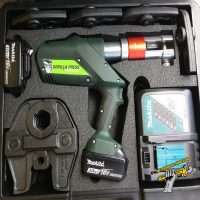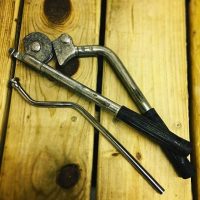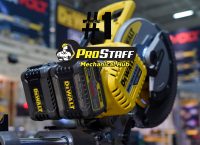Innovation takes on many forms, but in the world of plumbing and HVAC piping systems, change and or progress has been somewhat slow to take place. Copper press fitting systems have been on the scene for nearly 20 years in the U.S., even longer in Europe, but industry-wide adoption is a work in progress. If Read more
Industry Blogs

Innovation takes on many forms, but in the world of plumbing and HVAC piping systems, change and or progress has been somewhat slow to take place. Copper press fitting systems have been on the scene for nearly 20 years in the U.S., even longer in Europe, but industry-wide adoption is a work in progress. If you’ve been following us here on The Hub you already know my opinion that pressing copper or iron pipe for nearly every application is not only efficient but also profitable for any size contracting firm. But I’m not here to debate the merits of press versus soldering or threading; instead, I’d like to talk about a couple new tools we’ve had in the shop for review.
The new Gorilla™ pressing tool line features two unique tools: the inline battery pressing tool (INLNPRESS-KIT19kN) and the pistol grip battery powered pressing tool (PSTLPRESS-KIT32KN). I’ve personally put both tools to work on a handful of plumbing and heating projects over the last month, and I’m impressed.
Not unlike other press tools in the market the Gorilla press tools will complete a watertight connection, whether pressing copper, steel or PEX, with a 3-5 second cycle time. Here are the features of each tool kit broken down separately:
The larger of the two Gorilla press tools is capable of pressing up to 2″ copper or steel fittings with the included tongs/jaws. When equipped with compatible jaws such as the RIDGID XL-C or Milwaukee M18 ring sets the pistol tool is capable of joining 2-1/2″ thru 4″ copper and steel. Greenlee offers additional factory supplied jaw sets for PEX Press systems (NIBCO) as well.
The key here is jaw compatibility. For contractors who already own other press tools or for those looking at a new press tool as a first purchase knowing what tool is right for you based on its capabilities should be the focus. The PSTL tool is compatible with all of the Viega PROPRESS copper, stainless and iron pipe (MEGAPRESS) fitting systems when either using the Greenlee jaw sets for 2″ and smaller copper or the RIDGID or Milwaukee M18 jaws for XC copper fittings or MEGAPRESS. A list of compatible jaw sets is included at the bottom of this review.
The PSTL-KIT32kN kit includes six V-profile copper/steel press jaws in sizes from 1/2″ to 2″, two 3.0Ah 18V Makita battery packs, rapid battery charger and heavy duty case with foam tool organizer insert. The 7,200 lb (32kN) force is delivered to the jaw set at the end of the swivel shaft. The unique pistol-grip offers an ergonomic design, placing the majority of the weight directly over the users hand and wrist for more balanced control when using the large diameter jaws. A single trigger deploys the hydraulic piston for a 3-5 second press cycle but is not automatic, requiring the user to fully depress the trigger for the entire cycle. However, once the press is complete, the tool retracts automatically, which does not require the operator to hold the trigger. In addition, the tools have the ability to retract the jaws at any point in time. An indicator light illuminates if the tool senses insufficient force during a press cycle and AUTOSTOPP technology stops the piston once optimal force is reached to complete the press of a fitting. The tool carries a 5-year warranty from the manufacturer and boasts the ability to go 40K press cycles before factory authorized service is required.
Inline Press (INLNPRESS-KIT19kN)
This is the more compact tool of the Gorilla lineup. Measuring in at just over 17″ when geared up with the 3/4″ copper jaws this swivel shaft tool is sleek and capable of sitting in tight spaces where only one hand may be appropriate for tool operation. The 4,275 lb (19kN) force tool features a single trigger, swivel head and 18V Makita 2.0Ah 18V battery.
The inline tool is capable of pressing both PEX press [up to 1-1/2″, see video] and v-profile copper/steel fittings (Viega type) up to 1-1/4″ diameter making it prime for all residential applications. As with the pistol tool the inline tool carries a 5-year manufacturer warranty and is capable of pressing 40K times in between service intervals. Press cycle time is 3-5 seconds depending on fitting type and diameter. The user is required to depress the trigger for the entire press cycle until the AOTOSTOP technology feature senses sufficient force, the piston retracts automatically the same as the pistol tool. The kit includes two Makita 18V batteries, rapid charger and heavy duty case with rigid foam organizer insert.
Recap
Overall the build quality of the Greenlee Gorilla press tools is high. Having been manufactured in Germany by the Greenlee owned Klauke tool company they’re developed from years of pressing experience and thousands of tools having been in use for many years. The 5-year warranty is impressive and compatibility with other manufacturer jaw sets makes both models very attractive in my opinion. Current jaw offerings open these tools up to the popular Sporlan Zoomlock refrigeration press fitting system as well even further expanding the capabilities and usefulness of these tools to HVAC contractors as well as plumbers. The Inline tool kit should be expected to price out between $2,100-$2,300, the more capable pistol tool will cost a contractor $3,300-$3,500 for the kit making both tools competitive in the press tool market.
https://www.youtube.com/watch?v=z9SXJYzzIGw
https://www.youtube.com/watch?v=Cys2STrvtRc

I often think of a hydronic systems as a living and breathing thing, like a human body. The hydronic system carries BTUs to the extremities of the building, like a body’s circulatory system, and the circulator pumps are the heart. We have been told that the heart is the strongest muscle in the body, using Read more
I often think of a hydronic systems as a living and breathing thing, like a human body. The hydronic system carries BTUs to the extremities of the building, like a body’s circulatory system, and the circulator pumps are the heart. We have been told that the heart is the strongest muscle in the body, using considerable energy. Without the heart, the body goes “down.” Similarly, pumps use considerable energy, and are vital to the building’s continued operation.

Pumping energy is not the first thing that comes to mind for most when speaking of energy efficiency. However, pumping of the fluid for a hydronic system can be optimized in many different ways, providing impressive savings.
The geothermal industry has been using food safe propylene glycol for years in geothermal and hydronic systems. Water is the basis and standard for the best in fluid viscosity and energy efficiency, but in order to maintain fluid integrity and protect against freezing, glycol is necessary in geothermal and hydronic distribution systems.
Hydronic systems are the most energy efficient way to move BTUs around a building in every situation of which I am aware. Viewing the chart below, you can see that air distribution systems expend up to 45% of their energy just to move energy around the building (fan power).
This is why distributed Geothermal Heat Pump systems are so efficient. Rather than large ducts to pump high volumes of air to different zones, GHPs are placed in the individual zones. Many times, these GHPs can provide radiant heating and cooling, further optimizing the energy consumption for distribution to as low as 20% of the total energy consumption.
In any building with a forced air HVAC system, switching to hydronic distribution can save 25% or more on energy costs. Pumping power is sometimes difficult to quantify. For geothermal ground loops, one directive is that pumping power of about 5 hp per 100 tons tends to be the best efficiency (Modern Geothermal HVAC Engineering and Control ApplicationsISBN-10: 0071792686; ISBN-13: 978-0071792684, p 151). The text from Dr. S.P. Kavanaugh goes on to say that pumping power should not be higher than 10 hp per 100 tons.
There are many situations by which the pumping power can be reduced by good engineering practices. Some of these practices include adequate pipe sizing and good construction practices, including pump, valve, and control selection. For example, rather than direct or reverse return, a system can be designed using decoupled secondary circuits with individual circulators, sometimes reducing the pumping power of a hydronic distribution system by 40% or more.
The pumping power of the single pipe system is lower than that of any other. In a single pipe hydronic system, pumping energy is reduced by design to the lowest extent possible. The more common hydronic system is a reverse return and uses two pipes for distribution. Electrical consumption in a hydronic system can be reduced from 45% to about 20% of total load by applying good hydronic practice.
A water based hydronic system with no additives is proven to have the lowest viscosity and best heat transfer properties. But that’s simply not possible most of the time. Glycol and various chemicals must be added to provide freeze protection and to maintain fluid integrity for protection and longevity of the components in a hydronic system. As the concentration of glycols go up, so does the viscosity and the pumping power requirement
A company has developed an FDA approved non-petroleum glycol that has a fluid viscosity that can save 40% or more on pumping power. In addition, this glycol has a greater capacity to move energy. In the graph below, at 32F (0C), propylene glycol solutions are more than twice the Kinematic Viscosity of their non-petroleum based FDA approved glycol (Kilfrost GEO).
Many authorities having jurisdiction require food safe glycol to be used in hydronic systems. Additionally, geothermal exchangers should be designed to protect the drinking water aquifers into which they are inserted. In some areas, ethylene glycol is considered acceptable, but many allow only FDA approved products.
There is one more part to the energy story. Water alone is the best vehicle for carrying BTU energy. As glycol is added, the “Prandtl Number” goes up, denoting decreased heat transfer efficiency. The Kilfrost GEO product has a better heat transfer efficiency than any other glycol listed for hydronic systems.
Your Customer is Worth It
Unfortunately, there are those contractors that will put in an expensive, high quality piece of equipment and then install the least expensive thermostat possible. We’re not about to do that. I learned a long time ago to offer the best quality available, and then the consumer can make the choice to downgrade if they choose. I’ve found that any consumer with the wisdom to choose a high quality HVAC system will also choose the high-end specialties.
As a case in point, geothermal systems often have a higher up-front cost than air-sourced HVAC systems; primarily because the in-ground heat exchanger is a major portion of the project’s cost. The highest quality pipe and valves are specified for these systems. The fluid running through the pipes should be the best available at any price. When considering glycol for any hydronic system, and especially a geothermal system, here are some considerations to take into account.
Glycol Considerations:
- Fluid Efficiency
- Increase performance and save money
- System Protection
- Ensure reliability and confidence
- Personnel & Environmental Risks
- Protect the aquifers and the environment
- Food safe
- FDA approved ingredients
Knowing what I do about how significant pumping energy can be, I would prefer to have a non-petroleum based glycol that can also reduce pumping energy consumption by 25% or more. I am reasonably certain that any client would make the same decision.
There has never been a better time to get involved in geothermal HVAC systems. Get trained as a designer or installer of geothermal systems. To find out more, visit IGSHPA.org and GEO, our industry organizations. IGSHPA already is training our building inspectors on geothermal heating and cooling systems.
Geothermal; Luxury and Peace of Mind
 Jay Egg is a geothermal consultant, writer, and the owner of EggGeothermal. He has co-authored two textbooks on geothermal HVAC systems published by McGraw-Hill Professional. He can be reached at jayegg.geo@gmail.com.
Jay Egg is a geothermal consultant, writer, and the owner of EggGeothermal. He has co-authored two textbooks on geothermal HVAC systems published by McGraw-Hill Professional. He can be reached at jayegg.geo@gmail.com.
*Modern Geothermal HVAC Engineering and Control ApplicationsISBN-10: 0071792686; ISBN-13: 978-0071792684, p 151 Copyright ©EggGeothermal Consulting and McGraw-Hill Education
** Copyright © Kilfrost ®Group Public Limited Company dated 2015. All rights reserved.
DropBox Folder to Correlating Slides

It’s well-known that copper (2″ and down) has dominated the hydronic heating and cooling market for decades. However, with the need to value engineer projects and still ensure high quality while staying on schedule, professionals in the industry are looking to new materials for solutions to improve profitability, increase system performance and meet the tight Read more
It’s well-known that copper (2″ and down) has dominated the hydronic heating and cooling market for decades. However, with the need to value engineer projects and still ensure high quality while staying on schedule, professionals in the industry are looking to new materials for solutions to improve profitability, increase system performance and meet the tight deadlines that always accompany commercial projects.
Enter PEX.
PEX is a durable piping material that is increasingly proving its value in commercial hydronic applications for transporting water to terminal units such as chilled beams, fan coil units, baseboards, radiators, hydronic VAV (variable air volume) reheat coils and radiant manifolds. Its flexibility, corrosion-resistance, price stability and overall performance make it superior to copper in many ways. In fact, more than 17 billion feet of PEX has been installed in plumbing, heating and cooling applications around the world — so quite a large number in the industry have already experienced the proven performance of PEX.
 However, some have a perception of PEX pipe as being a cheap and flimsy alternative to copper. They don’t recognize it for being the durable, commercial-grade product that more and more engineers are specifying and more and more mechanical contractors are installing in hydronic applications.
However, some have a perception of PEX pipe as being a cheap and flimsy alternative to copper. They don’t recognize it for being the durable, commercial-grade product that more and more engineers are specifying and more and more mechanical contractors are installing in hydronic applications.
PEX is showing its versatility for hydronic piping systems in both new construction and retrofit applications, such as The Wick Tower and Homewood Suites restoration projects or The Homestead at Rochester and Episcopal Homes senior housing expansion projects.
For those that are unfamiliar with the product, there are three different types of PEX (based on the crosslinking manufacturing method) — PEX-a, PEX-b and PEX-c. PEX-a is considered the superior PEX in the industry due to its higher crosslinking which makes it more flexible and durable compared to the other two forms.
PEX-a is regulated by ASTM F876, which denotes temperature and pressure ratings of 200°F at 80 psi, 180°F at 100 psi and 73.4°F at 160 psi. These values are well within the range of operation for the vast majority of hydronic systems. (This is especially true with the industry’s focus on energy efficiency and the trend to use higher water temperatures in cooling and lower water temperatures in heating.)
Bridging most differences between PEX-a and copper in hydronic applications is the PEX-a Pipe Support, a galvanized steel channel that provides continuous support in suspended-piping applications. The supports permit hanger spacing similar to copper pipe, reducing the required number of hangers by half. And since fewer hangers mean lower material and labor costs, use of the PEX-a Pipe Support results in a less-expensive installation.
PEX-a Pipe Support also controls the natural expansion and contraction that occurs as PEX piping heats and cools. PEX-a has a free-body expansion rate of 1.1 inches per 100 feet per 10⁰F ∆T, or 10 times that of copper. Installing anchors every 65 feet and using PEX-a Pipe Supports allows PEX-a to function much like a copper system.
The support also addresses aesthetic concerns some may have with PEX. Commercial contractors and building owners typically expect long, evenly spaced, rigid pipelines running through their hydronic systems. Supporting the PEX resolves this by reinforcing and covering the pipe.
So if you’ve heard about (or seen) PEX in a hydronic piping application and are curious if it can work for your next project, take a look at what PEX can do for you. You might just be the next one to experience the proven performance of PEX.
 Kim Bliss is the technical communications manager at Uponor. She can be reached at kim.bliss@uponor.com.
Kim Bliss is the technical communications manager at Uponor. She can be reached at kim.bliss@uponor.com.

One of my favorite parts of my job is meeting people from all over the world working in the trades. John and I have met face to face with dozens of plumbing and heating pros at trade shows, on job sites and at industry events but its our daily interaction on social media that puts Read more
 One of my favorite parts of my job is meeting people from all over the world working in the trades. John and I have met face to face with dozens of plumbing and heating pros at trade shows, on job sites and at industry events but its our daily interaction on social media that puts us in contact with countless new friends annually that keeps us on our toes.
One of my favorite parts of my job is meeting people from all over the world working in the trades. John and I have met face to face with dozens of plumbing and heating pros at trade shows, on job sites and at industry events but its our daily interaction on social media that puts us in contact with countless new friends annually that keeps us on our toes.
Whether on Facebook, Twitter or Instagram I get messages weekly from seasoned pros to new guys and gals just entering the trades. Some are sharing their experiences with a certain product, pictures of an install they’re proud of or something crazy they encountered on a job. Often I’m asked by the new hires the same question: What’s that one tool or few tools you just can’t be without?
I never have a solid answer, or at least the one they’re likely expecting. For me that one tool I couldn’t be without is the only tool needed to complete the job at hand. So the answer is “all of them”, I suppose.

Take this basic tubing bender. It’s as old as the hills, super simple and will outlast my career as a plumbing and heating contractor. It’s only good for about one or two things but without it what could’ve been a simple task to turn out a proper product, I’d instead be hand-bending and likely taking too long to get an offset right or simply ending up with a crappy looking bend. I don’t even use it every day, I have others for various size tubing and wouldn’t want to be without those either, no matter how infrequent they leave the truck.
The point is there are obviously a handful of essential tools but if you need to be told to never forget your tape measure then we’re not talking about the same thing. My advice is this: Pay attention to what you’re doing daily, weekly, monthly and make note of the tools you use on a regular basis. Then, buy the best available within your budget and they’ll last you a long time, like this Imperial-Eastman bender that my now retired Grandfather gave me when I started out over 20 years ago. It wasn’t new then and it’s bent at least a few thousand offsets over the years. To all the new guys and gals I say good luck and don’t hesitate to contact us!

My pick for number one in the Top Tools of 2016 is the DEWALT Flexvolt system. Picking only one tool from the growing list of Flexvolt tools would be tough, I’m not even sure where I’d start but I suppose I’d have to first consider the first battery to hit the scene that actually changes Read more
My pick for number one in the Top Tools of 2016 is the DEWALT Flexvolt system. Picking only one tool from the growing list of Flexvolt tools would be tough, I’m not even sure where I’d start but I suppose I’d have to first consider the first battery to hit the scene that actually changes voltages depending on the tool it is connected to. I picked the whole system of Flexvolt tools because only choosing the battery pack would leave out the high performance tools Dewalt had engineered to do mass amounts of work on the voltage-changing platform. Picking one specific tool would then take the honor of being the number one tool away from the battery pack; an honor that really belongs to Dewalt and the whole Flexvolt system.
 Cordless job sites are now a reality. We’ve been gearing up for this for the last 4-5 years but falling short in key areas, some trade specific. The plumber, hvac installer and electrician have had a cordless drilling option for stud and joists for almost two years from a major competitor. Dewalt’s new Flexvolt 60v MAX VSR Stud & Joist Drill is built for rough-in drilling of large diameter holes in wood. I’ve pitted the VSR up against the Super Hawg multiple times as have others with the results always stacking in Dewalt’s favor. The speed and constant power along with the battery’s ability to remain cooler allow this drill to perform longer and drill more holes than its nearest competitor.
Cordless job sites are now a reality. We’ve been gearing up for this for the last 4-5 years but falling short in key areas, some trade specific. The plumber, hvac installer and electrician have had a cordless drilling option for stud and joists for almost two years from a major competitor. Dewalt’s new Flexvolt 60v MAX VSR Stud & Joist Drill is built for rough-in drilling of large diameter holes in wood. I’ve pitted the VSR up against the Super Hawg multiple times as have others with the results always stacking in Dewalt’s favor. The speed and constant power along with the battery’s ability to remain cooler allow this drill to perform longer and drill more holes than its nearest competitor.
60V Max is about building more powerful and more capable tools. At higher voltages, less current draw is needed to achieve the same power output, and that means greater efficiency and lower losses. It is this exact engineering that keeps the Flexvolt tools running longer than their competitors and that means less downtime. Less downtime means more work is being done.  The Flexvolt system is more than a powerful drill and high capacity battery though. I’ve been working with the 12” 120V double bevel compound miter saw kit for months now in my shop. Because of the battery’s engineering this typically corded tool is able to operate as a cordless tool but with corded performance characteristics. Dozens and dozens of cuts can be made with either (2) Flexvolt packs or the 120V corded power adaptor.
The Flexvolt system is more than a powerful drill and high capacity battery though. I’ve been working with the 12” 120V double bevel compound miter saw kit for months now in my shop. Because of the battery’s engineering this typically corded tool is able to operate as a cordless tool but with corded performance characteristics. Dozens and dozens of cuts can be made with either (2) Flexvolt packs or the 120V corded power adaptor.
Flexvolt is also a 20V system for tools like typical drills and impact drivers. The voltage switch for 20V MAX tools allows for the new Flexvolt batteries to be backwards compatible with existing 20V MAX tools the whole platform of tools operating on the battery system. Each of the Flexvolt tools we’ve tested has been outstanding in all performance ratings. The ergonomics of these heavy-duty, high demand tools shows an improvement over previous 20V MAX tools as well. Durability and life span have not been confirmed yet because all of our tools are less than a year old now but I will continue to push them to the limit on the job and report back if anything out of the norm happens.
The Flexvolt battery automatically switches between two voltages, 20V & 60V. The ability to use a single battery in multi-volt applications improves worker efficiency and expands the types and amount of tools capable of moving from corded to cordless. For more information on how the batteries are built and operate see below.
SERIES MODE
 In parallel mode [20V MAX] the Flexvolt 15-cell battery can deliver up to 4X the runtime** to your current 20V MAX* tools. In this mode, three sets of five cells each are connected in parallel to give you 20V MAX* and 6 Ah for increased runtime. New 9 Ah packs are now available, increasing the runtime and tool performance even further.
In parallel mode [20V MAX] the Flexvolt 15-cell battery can deliver up to 4X the runtime** to your current 20V MAX* tools. In this mode, three sets of five cells each are connected in parallel to give you 20V MAX* and 6 Ah for increased runtime. New 9 Ah packs are now available, increasing the runtime and tool performance even further.
PARALLEL MODE
 When you mate the Flexvolt battery into the new line of 60V MAX brushless tools, the battery automatically changes to SERIES MODE. In this mode, all fifteen cells are connected in series to provide 60V MAX for the power of corded. Around the shop we have started to call this BEAST MODE. The Flexvolt 6Ah packs are built with 18650 sized lithium cells. The 20V MAX and Flexvolt 9Ah packs are built with 20700 form factor cells. 20700 sized cells are larger and capable of delivering more power the 18650 sized cells of the same charge capacity.
When you mate the Flexvolt battery into the new line of 60V MAX brushless tools, the battery automatically changes to SERIES MODE. In this mode, all fifteen cells are connected in series to provide 60V MAX for the power of corded. Around the shop we have started to call this BEAST MODE. The Flexvolt 6Ah packs are built with 18650 sized lithium cells. The 20V MAX and Flexvolt 9Ah packs are built with 20700 form factor cells. 20700 sized cells are larger and capable of delivering more power the 18650 sized cells of the same charge capacity.
If impacts, drills or saws aren’t enough Dewalt has brought a industry first to the job site with the DCB1800 Powerstation. The power station is a portable generator running off (4) 20v MAX batteries, not a gas engine so indoor use is not a problem. The inverter is silent in comparison to any other portable power solution as well making it a non-factor where noise is a obstacle to getting the job done. This is a gamechanger for those looking to knock out some punch list items at the end of the job or quickly get in and out to complete a task with a corded tool when cordless isn’t available.
https://www.youtube.com/watch?v=bHT9eJi9cvM
Check out the complete list of Top Tools of 2016



- Top Tools of 2016: #10











